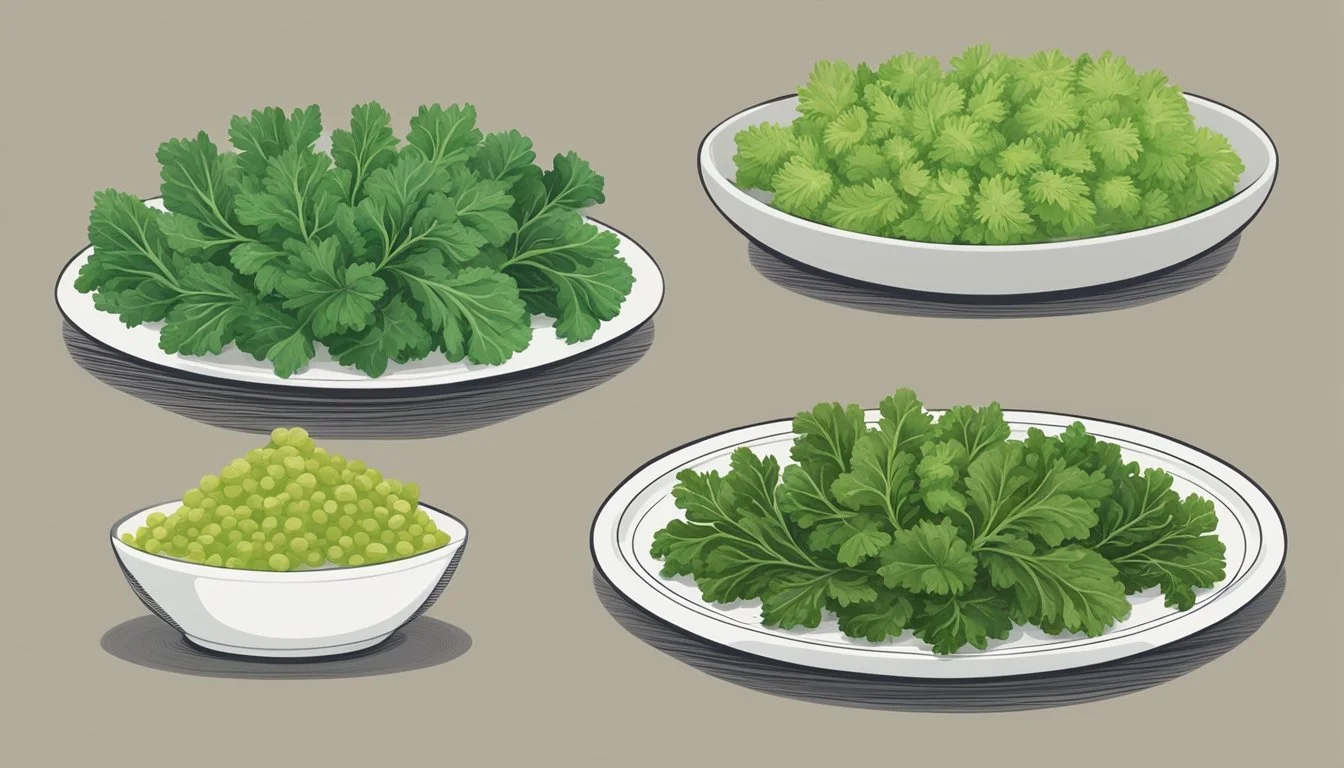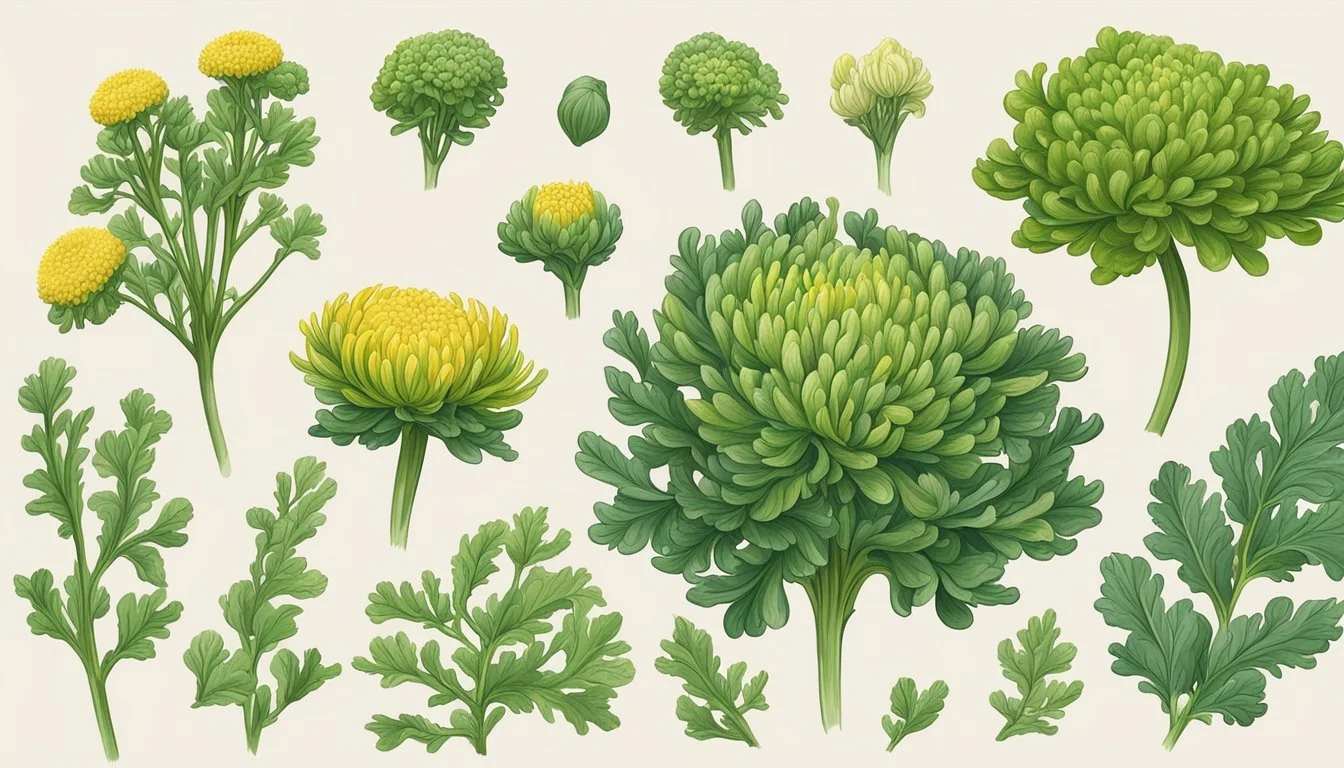Chrysanthemum Greens Substitutes
Best Alternatives for Your Recipes
Chrysanthemum greens, known as shungiku in Japan, are versatile leafy vegetables often used in Asian cuisines thanks to their mildly bitter taste and distinctive aroma. These greens, whether eaten raw or cooked, bring a unique flavor to simple meals and authentic flavors, making them a cherished ingredient in many dishes. However, if you can't find chrysanthemum greens or simply want to try something different, several substitutes are available that are equally nutritious and delicious.
Tatsoi, for instance, is a great alternative. This leafy green from the Brassica family delivers a mild taste and tender texture, perfect for stir-fries or fresh salads. Another excellent option is amaranth greens, which offer a slightly earthy flavor and can be used in various cooked or raw recipes, enhancing your dish without overpowering it.
Ashitaba, a member of the celery family, is also an highly nutritious substitute. As a rich source of vitamins and minerals, it can be used not just as a replacement but also as a star ingredient in your meals. Each of these alternatives provides unique flavors and textures that can easily adapt to your culinary needs, ensuring you can enjoy nutritious and tasty dishes even without chrysanthemum greens.
Understanding Chrysanthemum Greens
Chrysanthemum greens, also known as garland chrysanthemum or crown daisy, are a popular ingredient in various cuisines. They belong to the Asteraceae family and are known for their distinctive aroma, herbaceous flavor, and significant nutritional benefits.
Culinary Uses
Chrysanthemum greens are a versatile ingredient in East Asian cuisine. They are commonly prepared in salads, soups, stews, and hot pot dishes. Raw or lightly cooked, the leaves offer a crunchy texture and have a mildly astringent taste.
When using chrysanthemum greens, it's essential not to overcook them. Prolonged cooking can turn them into mushy, slimy clumps. The best method is to blanch or sauté them briefly. They can also be paired with dressings, such as a sesame vinaigrette, to highlight their unique flavor.
Health Benefits
Chrysanthemum greens are packed with nutritional benefits. They are an excellent source of vitamins and minerals, including vitamin C, potassium, iron, and calcium. These greens are also rich in fiber and antioxidants.
Regular consumption can support a healthy immune system, improve bone health, and aid digestion. The presence of antioxidants helps combat oxidative stress. This makes chrysanthemum greens a great addition to a balanced diet and useful for maintaining overall well-being.
Distinctive Characteristics
Chrysanthemum greens are distinguished by their dark green leaves and aromatic scent. They belong to the Chrysanthemum Coronarium species within the Asteraceae family. The leaves can vary between broad and narrow shapes.
Their flavor profile is herbaceous with a hint of bitterness. The unique astringent taste can be balanced with acidic or sweet dressings. Texture-wise, the greens offer a satisfying crunch when eaten raw and a tender bite when cooked correctly.
These characteristics make them distinct from other leafy greens and a notable ingredient in culinary traditions across East Asia.
Common Substitutes for Chrysanthemum Greens
Substituting chrysanthemum greens can be accomplished with a variety of other nutritious and flavorful vegetables. This ensures that dishes still retain a balance of taste, texture, and essential nutrients.
Spinach
Spinach offers a mild taste and versatile texture, making it an excellent substitute. Rich in iron, vitamins A and C, and calcium, spinach can be used both raw and cooked. Its broad, tender leaves work well in salads, and its ability to wilt quickly makes it ideal for boiling or simmering in soups and stews. The neutral flavor of spinach means it can easily take on other flavors, such as garlic or a sesame dressing.
Kale
Kale is known for its slightly bitter and robust flavor, along with a crunchy texture. It's packed with vitamins K, A, and C, as well as iron and fiber. Kale works well in both cooked dishes and salads, providing a nutritious and hearty alternative to chrysanthemum greens. It's particularly effective when sautéed with garlic or added to soups, as its texture holds up well under heat. The sturdy leaves can also be massaged to soften them for salads or made into chips.
Watercress
Watercress has a peppery flavor and crisp texture, bringing a distinct taste to dishes. High in vitamins A, C, and K, as well as calcium and iron, it's a nutrient-dense option. Watercress can be used in Mediterranean salads or Japanese cooking for a fresh, spicy kick. It’s also delightful as a garnish or in sandwiches. Its peppery notes can stand up to strong dressings and mix well with other ingredients.
Arugula
Arugula, with its distinct peppery flavor, makes for an interesting substitute. Rich in vitamins A, K, and C, as well as iron and fiber, it adds a dynamic taste to both salads and cooked dishes. Arugula is commonly used in Mediterranean salads, pairing well with tomatoes, garlic, and toasted sesame seeds. This leafy green’s crunch and slight bitterness can effectively replace the earthy notes of chrysanthemum greens.
Mizuna
Mizuna is often found in Japanese cooking and has a mild, slightly peppery flavor. High in vitamin C, A, and iron, mizuna is nutritious and versatile. Its delicate leaves are suitable for salads, while its sturdiness allows it to be boiled or added to soups and stews. Mizuna’s crunchy texture and ability to absorb flavors make it a suitable stand-in for chrysanthemum greens, providing both taste and nutritional benefits.
Preparing and Cooking Substitutes
When substituting chrysanthemum greens, consider the texture, aroma, and cooking time. Understanding different techniques and flavor combinations helps replicate the authentic taste.
Blanching Techniques
Blanching keeps greens vibrant and crisp. Bring a pot of water to a rolling boil. Add a pinch of salt to enhance color and flavor. Submerge the greens for no more than 30 seconds, then quickly transfer them to ice water to halt cooking.
Timing and temperature are key to avoid overcooking greens. Proper blanching preserves the texture, making them suitable for salads and stir-fries. This method also works well for spinach, bok choy, and ashitaba.
Incorporating Into Dishes
Substitute greens can be added to a variety of cooked dishes. Stir-fries, hot pot, and soups benefit from their distinct flavors. Heat sesame oil in a pan, quickly stir-fry the greens, and add a splash of soy sauce or mirin for depth.
Nabemono and shabu-shabu recipes call for the short cooking time of these greens, keeping their texture firm. Add blanched greens to sukiyaki or simmer with other vegetables for a nourishing soup.
Creating Flavorful Profiles
To create authentic flavors, using ingredients like sesame paste, miso, and garlic can enhance the substitute greens. Mix soy sauce with a touch of sugar and sesame oil. Drizzle over blanched greens for a simple, savory side dish.
Toasted sesame seeds and a light salad dressing bring out the greens' natural aroma. Experiment with different combinations like sesame paste and garlic for a unique profile. Simple meals gain complexity with these carefully paired flavors.
Proper preparation and seasoning ensure that substitute greens deliver the desired texture and taste. Whether in soups, hot pots, or stir-fries, thoughtful techniques and flavors make these greens a versatile addition to various dishes.
Nutritional Comparisons
Chrysanthemum greens are rich in various nutrients, making them a valuable addition to the diet. They contain high levels of Vitamin A, which supports vision and immune function. Additionally, Vitamin C in these greens contributes to skin health and improves iron absorption.
Minerals found in chrysanthemum greens include calcium, essential for bone health, and potassium, which helps regulate blood pressure. Iron content in these greens supports the production of healthy red blood cells.
Nutrient Chrysanthemum Greens Vitamin A High Vitamin C High Calcium Moderate Potassium High Iron Moderate
These greens are also a good source of dietary fiber, which promotes digestive health. Their antioxidants help neutralize free radicals and reduce oxidative stress.
In terms of nutritional benefits, chrysanthemum greens offer a crunchy texture that remains intact when lightly cooked, adding variety to meals. They can stand in for other leafy greens like lettuce in salads or be used in soups and stews.
Because of their rich nutrient profile, these greens can contribute significantly to a balanced diet, providing essential vitamins and minerals while enhancing both flavor and texture in a wide variety of dishes.
Eating chrysanthemum greens can be an excellent way to ensure the intake of key nutrients that support overall health and well-being.
Cultural and Regional Variations
Chrysanthemum greens, known for their unique flavor profile, are an essential ingredient in various Asian and Mediterranean dishes. They play a significant role in many traditional recipes and have different names and uses depending on the region.
Japanese Varieties
In Japan, chrysanthemum greens are known as shungiku and are a staple in several dishes. They are often used in nabe (Japanese hot pot) and sukiyaki due to their mild bitterness and aromatic qualities. Shungiku can be eaten raw in salads or lightly cooked, retaining a distinct crunch. These greens pair well with tofu and miso, enhancing the flavor profile of various Japanese cooking recipes.
Korean Alternatives
Chrysanthemum greens are popular in Korean cuisine where they are called tong ho or "ssukgat." They are commonly found in hot pots and stews, adding a slightly bitter taste that balances rich broths. Tong ho can also be stir-fried or used in chop suey greens dishes. The greens are valued for their medicinal properties and are often included in culinary practices aimed at promoting health.
Mediterranean Influences
In Mediterranean cuisine, chrysanthemum greens are less common but can be substituted with similar bitter greens like arugula. They are included in cooked dishes where their peppery flavor can add a unique twist. Mediterranean recipes may use them in salads, soups, or as a garnish to enhance the nutritional content. Though not traditional, these greens can be an innovative addition to Mediterranean cooking, offering a new flavor profile.
Storage and Preservation
To maintain freshness, chrysanthemum greens should be stored properly.
First, remove any wilted leaves. They can cause the rest of the greens to spoil faster. Once the wilted leaves are removed, wash the greens thoroughly.
Refrigerator Storage: Place the washed greens in a plastic bag or a container. Ensuring some air circulation can help keep them fresh longer. They can be stored in the crisper drawer for up to a week.
Blanching Method: For longer preservation, blanch the greens briefly in boiling water, then immediately cool them in ice water. After draining, the greens should be patted dry and stored in a sealed container or freezer bag. This method can extend storage for several months.
Freezing: If freezing, spread the dried, blanched greens on a tray to freeze individually before transferring to a sealed bag. This prevents clumping and makes it easier to use small portions later.
Avoid high humidity or moisture in the storage environment, as this can lead to quicker spoilage. Ensuring greens are dry before storage is crucial for longevity.
With these methods, chrysanthemum greens can be preserved effectively, retaining their nutritional value and flavor.
Growing Your Own Chrysanthemum Greens
Growing chrysanthemum greens, also known as shungiku, offers both a tasty addition to meals and a rewarding gardening experience. Chrysanthemum greens thrive in well-drained soil with a pH between 6.0 and 7.0.
Site Selection:
Select a location that gets full sun for at least 6 hours each day.
Some afternoon shade is beneficial, especially in hotter climates.
Soil Preparation:
Ensure the soil is free of debris and stones.
Loosen the soil to facilitate root growth.
Planting Seeds:
Sow chrysanthemum green seeds directly into the soil.
Plant seeds when daily temperatures range between 60-70°F for optimal growth.
Watering:
Keep the soil consistently moist, especially during the early stages.
Water generously for the first 1-2 weeks until the plants are established.
Maintenance:
Thin seedlings to allow enough space for mature plants.
Provide additional shade if temperatures exceed the ideal range.
Harvesting:
For a cut-and-come-again approach, start harvesting when plants are 2-4 inches tall.
To harvest the entire plant, wait 6-8 weeks until it grows to about 5-10 inches.
By following these steps, gardeners can enjoy fresh, homegrown chrysanthemum greens throughout the growing season.
Social Media and Online Resources
Exploring social media platforms can provide numerous insights into using chrysanthemum greens and their potential substitutes. Pinterest is an excellent resource for finding visually appealing recipes and tips on how to incorporate these greens into various dishes. Users share creative cooking ideas, often accompanied by step-by-step images.
YouTube offers a plethora of cooking tutorials that demonstrate the preparation of chrysanthemum greens. Channels dedicated to Japanese cuisine, such as "5 Secrets to Japanese Cooking," provide instructional videos. These tutorials often include substitutes and variations, giving viewers a hands-on guide.
Instagram is another valuable platform. Food bloggers and chefs regularly post photos and videos of their culinary creations using chrysanthemum greens. Hashtags like #Shungiku and #ChrysanthemumGreens can lead to a wealth of ideas, allowing users to discover new and interesting ways to use these greens.
Facebook groups and pages focused on Japanese cooking or specific ingredients can also be helpful. Members share recipes, substitution tips, and answer questions about sourcing ingredients. Discussions often highlight where to find these greens or suitable alternatives in different regions.
For those specifically interested in Japanese ingredient substitution, niche blogs and websites offer recommendations. "Just One Cookbook" is known for its detailed ingredient guides and substitution advice. It includes instructions on how to replace chrysanthemum greens with more readily available items while maintaining authentic flavors.
Utilizing these online resources can help home cooks stay informed and inspired in their culinary adventures with chrysanthemum greens and their substitutes.







